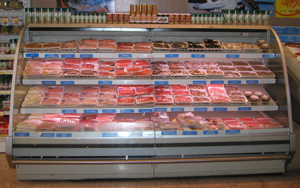Frozen Fish and Frozen Seafood Displays in Grocery Store and Fish Market Cabinets
Even frozen packages of fish and assorted seafood should look and smell fresh. Frozen fish fillets or steaks should be white or pink depending upon the species, while whole fish should have brightly colored or metallic scales and red or pink gills.
Yellow and green wavelengths are the most damaging wavelengths in the visible spectrum, and their predominance in regular fluorescent lighting can distort the natural colors of fin fish and seafood and make ice beds look green or yellow. Promolux fluorescent lamps and LEDs emit a more balanced range of wavelengths, which results in true color displays.
Decomposition of Frozen Retail Fish and Seafood Displays
Frozen fish is often packaged in a folded sleeve of plastic that is sealed shut with an ice glaze. In a damaged or loose fitting package that allows air in, display case lighting can trigger lipid oxidation of fish fats and lead to rancidity, which occurs even in sub-freezing temperatures and is notable as a brown or yellow discoloration and a strong fishy odor.
Radiation from display case lighting can accelerate the dehydration of fish, which may be seen as frost from drip as the cells lose the ability to retain water, or in extreme cases, freezer burn, which gives unpleasant flavors and white or yellow patches.
Frozen seafood should be stored at 0°F to -10°F (-17°C to -23°C); at these temperatures it will maintain its quality twice as long as at 10°F to 15°F (-12°C to -9°C). Fish kept frozen at -22°F can last from 9 months to 2 years.
Frozen puddles and runny color on the skin indicate that the fish has thawed and was refrozen. Seafood that was frozen slowly or stored at warm or fluctuating temperatures will be tough with excessive drip and a soggy, chewy, bland flavor, or may have a soft texture from structural damage caused by large ice crystals.
